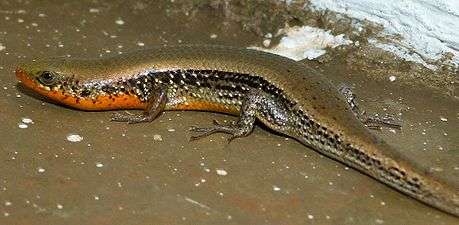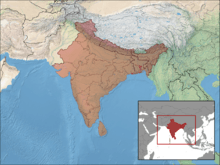Eutropis carinata
| Keeled Indian Mabuya | |
|---|---|
 | |
| Scientific classification | |
| Kingdom: | Animalia |
| Phylum: | Chordata |
| Class: | Reptilia |
| Order: | Squamata |
| Family: | Scincidae |
| Genus: | Eutropis |
| Species: | E. carinata |
| Binomial name | |
| Eutropis carinata (Schneider, 1801) | |
 | |
| Synonyms | |
|
Mabuya carinata (Schneider, 1801) | |
The Keeled Indian Mabuya (Eutropis carinata), also called Many-keeled Grass Skink or (ambiguously) "golden skink", is a species of skink found in South Asia.
Description
Body robust; snout moderate, obtuse. Lower eyelids scaly; vertebral scales smooth. Ear-opening roundish, sub-triangular. Brown to olive or bronze in color above, uniform or with dark-brown or black spots, or longitudinal streaks along the lateral margins of the scales. Sides are dark-brown or chestnut, with or without light spots. A light dorso-lateral line starting from above the eye and continued to the base of the tail. Lower parts whitish or yellowish.[1] Maximum length: 37 cm. and Common length: 25, in which Snout-vent length is 9 cm.[2]
Distribution
Frequently found in Bangladesh, India (except in the North-West), Maldives, Myanmar, Nepal & Sri Lanka and Possibly in Bhutan.
Habitat & Ecology
Sri Lanka subspecies lankae are encountered in many habitat types, from rain forests and deserts to scrub forests and parks and gardens of houses ad cities. Diurnal, and terrestrial, frequently seen basking or foraging in open areas.
Diet
Crickets, caterpillars, beetles, and earthworms and even small vertebrates are known to consume.

Reproduction
Oviparous; clutches of 2-20 eggs are laid at a time in a self-excavated hole or under fallen logs, between August and September. Eggs are measuring 11 * 17 mm. Hatchlings emerge between May and June, measure 12-12.5 mm.
Impact on human & echology
No known uses. May be used as a pet.
Play rolls on echo-system by eating various types of insects & other creatures and otherwise.
Interesting note
Can break off its own tail when grabbed by predators; the tail regenerative and will grow back over time.
IUCN status
Least Concern (LC).[3]
Notes
References
- Gray, J. E. 1846 Descriptions of some new species of Indian Lizards. Ann. Mag. Nat. Hist. (1)18: 429-430
- Smith, M.A. 1935 Reptiles and Amphibia, Vol. II. in: The fauna of British India, including Ceylon and Burma. Taylor and Francis, London, 440 pp.
External links
- Mabuya carinata at the Reptarium.cz Reptile Database
- http://itgmv1.fzk.de/www/itg/uetz/herp/photos/Mabuya_carinata.jpg
- http://itgmv1.fzk.de/www/itg/uetz/herp/photos/Mabuya_carinata1.jpg
- The Reptile Database: Eutropis carinata (SCHNEIDER, 1801)